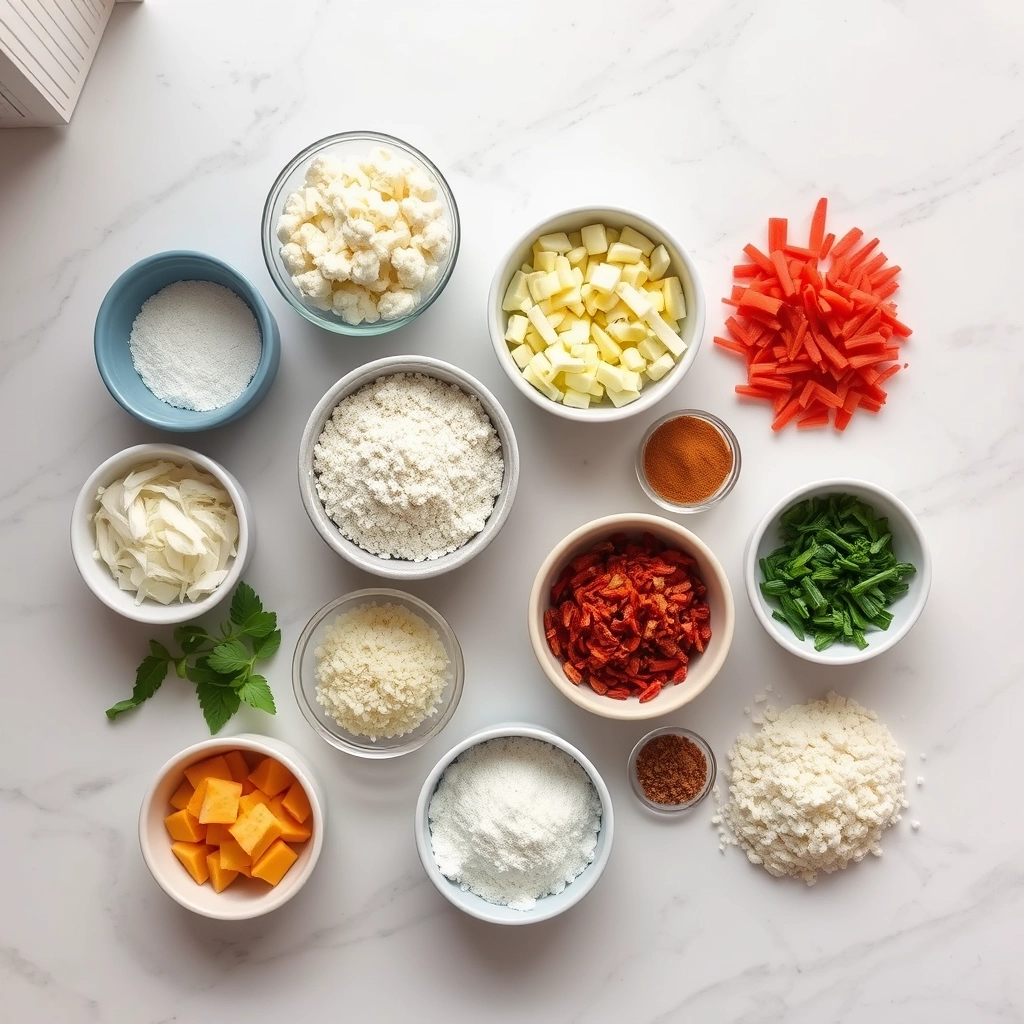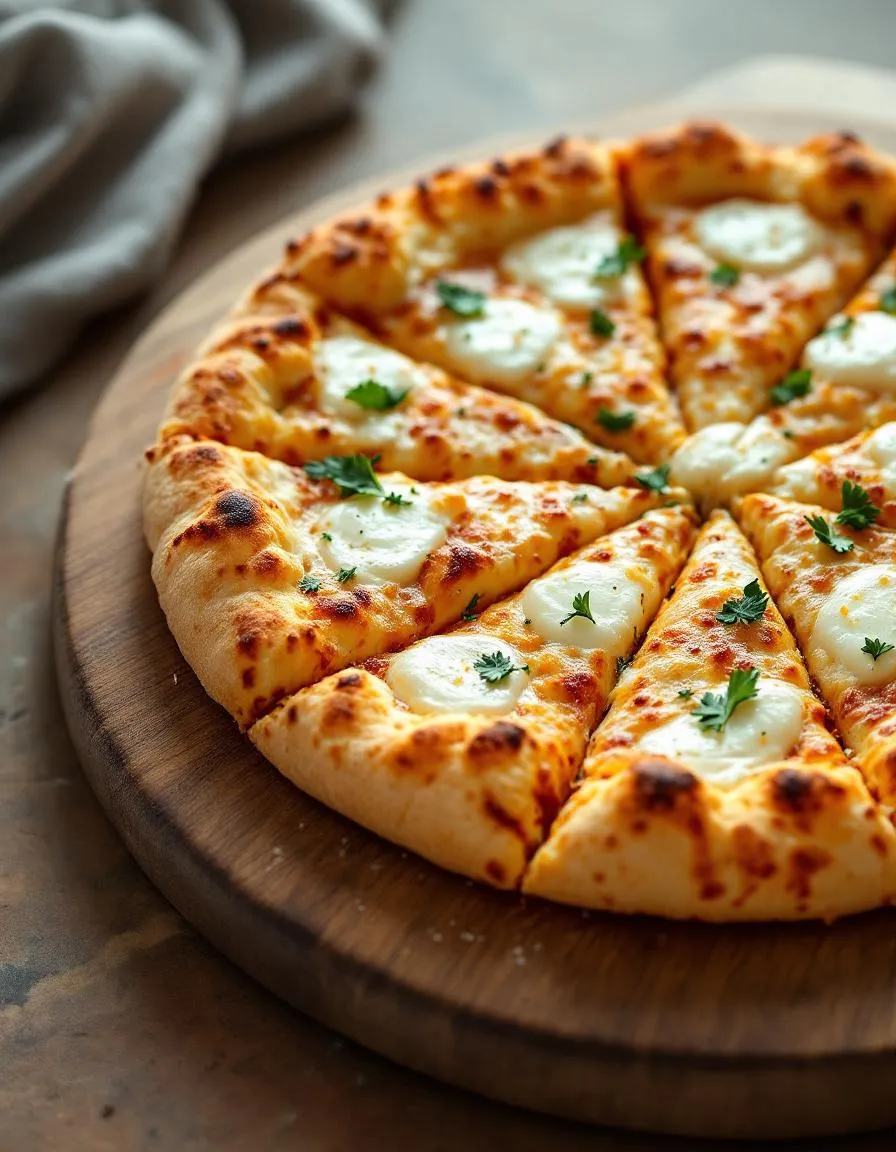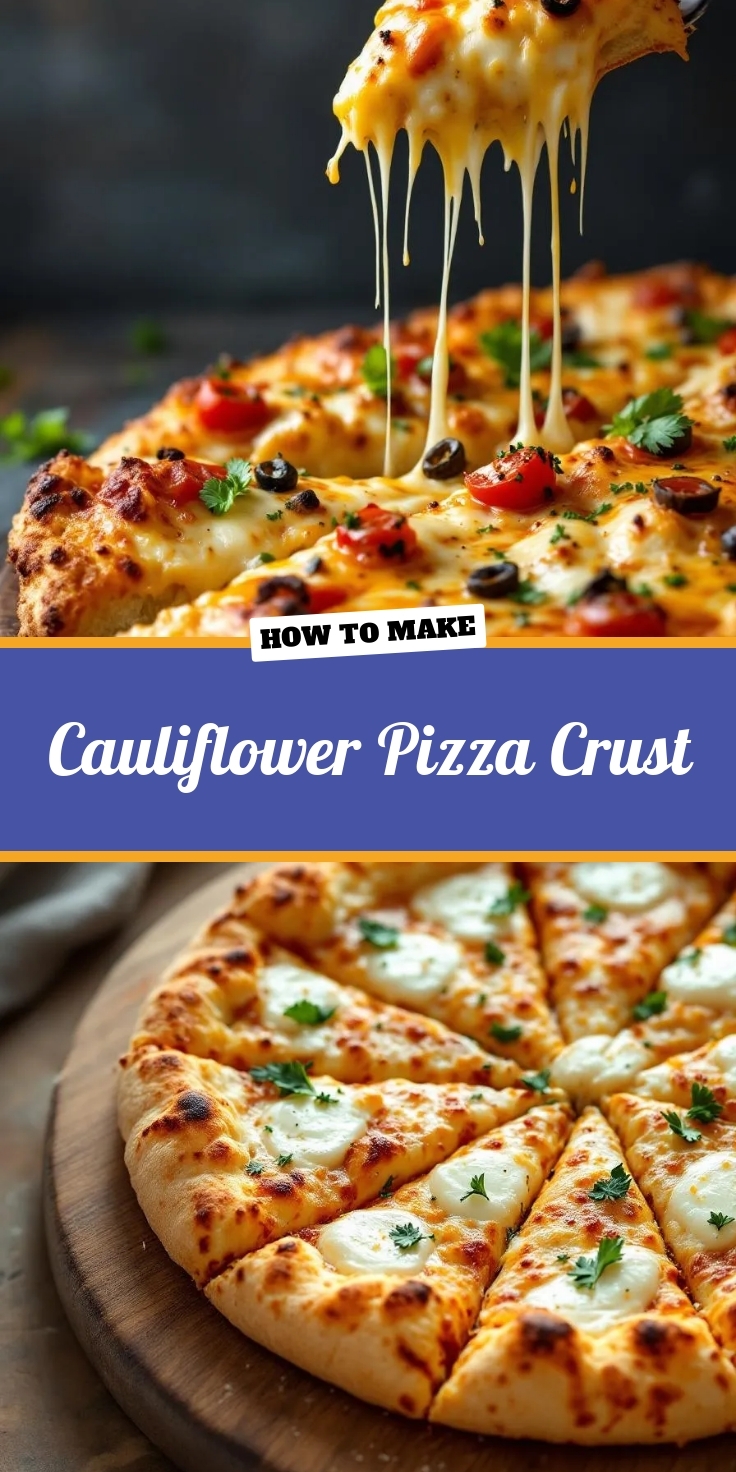Introduction
Hi there! I’m Emily, the heart and soul behind brekcakes.com. From my earliest memories, the kitchen has always been a place of warmth and creativity. It’s where I discovered the magic of turning simple ingredients into extraordinary meals and learned that the best dishes are often made with love as the main ingredient.
If you’ve ever craved pizza but wanted a lighter, veggie-packed alternative, you’re in the right place. Cauliflower Pizza Crust is a game-changer for anyone looking to enjoy their favorite comfort food without the guilt. Whether you’re gluten-free, keto-friendly, or simply love experimenting in the kitchen, this recipe delivers crispy, flavorful goodness that even picky eaters will adore. Plus, it’s a fantastic way to sneak more veggies into your meals—something I always encourage, especially in my family-friendly dinners.
Cauliflower Pizza Crust swaps traditional flour for finely riced cauliflower, creating a low-carb, nutrient-rich base that’s surprisingly sturdy. Unlike store-bought versions, homemade crust lets you control the texture and flavor, ensuring it’s perfectly crisp yet tender. This recipe aligns with my philosophy that healthy eating should never mean sacrificing taste or joy. In fact, it’s a staple in my meal prep ideas because it’s versatile and freezer-friendly. Whether you top it with classic marinara and cheese or get creative with pesto and veggies, this crust adapts to your cravings while keeping things wholesome.
Why I Love This Recipe
Cauliflower Pizza Crust holds a special place in my heart because it bridges the gap between indulgence and nourishment. When my sister first went gluten-free, I spent weeks perfecting this recipe so she could still enjoy our Friday pizza nights. The moment she took her first bite and smiled, I knew this crust was something worth sharing. It’s proof that with a little creativity, even the simplest ingredients can transform into something extraordinary—and that’s the magic I live for in the kitchen.
Health and Nutrition
Why it’s good for your body
Cauliflower Pizza Crust packs a nutritious punch while keeping your meals delicious. First, it’s naturally low in carbs, making it a smart choice if you’re watching your carbohydrate intake. Unlike traditional dough, cauliflower provides fiber, which supports digestion and keeps you feeling full longer. Additionally, this crust delivers essential vitamins like C and K, boosting immunity and bone health.
Because cauliflower is the star ingredient, you also get antioxidants that help fight inflammation. Meanwhile, the absence of refined flour means fewer blood sugar spikes, so you can enjoy your pizza without the energy crash. Plus, Cauliflower Pizza Crust often contains fewer calories than regular crust, helping you maintain a balanced diet without sacrificing flavor.
Another benefit is its versatility. Whether you load it with veggies or lean proteins, Cauliflower Pizza Crust adapts to your nutritional goals. Finally, its mild taste lets other healthy toppings shine, so you can create a meal that’s as nutritious as it is satisfying.
How it fits in a healthy lifestyle
Cauliflower Pizza Crust fits seamlessly into a balanced diet, whether you’re gluten-free, keto, or just aiming for healthier choices. For gluten-sensitive eaters, it’s a game-changer, offering a tasty alternative to wheat-based crusts. If you’re focused on heart health, the low saturated fat content supports better cholesterol levels, especially when paired with nutrient-rich toppings like spinach or grilled chicken.
Meal preppers love how easy it is to incorporate Cauliflower Pizza Crust into weekly plans. You can batch-make crusts and freeze them for quick dinners, ensuring healthy options are always on hand. For more gluten-free meal ideas, check out our guide to gluten-free baking. And if you’re exploring low-carb diets, our keto-friendly recipes offer plenty of inspiration. With this crust, you’re not just eating well—you’re making sustainable choices that align with your lifestyle.
PrintCauliflower Pizza Crust
Description
A low-carb, gluten-free pizza crust made from cauliflower that’s crispy and delicious.
Ingredients
For the Crust:
- 1 medium head cauliflower, riced
- 1 large egg
- 1/2 cup shredded mozzarella cheese
- 1/4 cup grated parmesan cheese
- 1/2 teaspoon dried oregano
- 1/2 teaspoon garlic powder
- 1/4 teaspoon salt
- 1/4 teaspoon black pepper
Instructions
1. Prepare the Crust:
- Preheat oven to 400°F (200°C) and line a baking sheet with parchment paper.
- Place riced cauliflower in a microwave-safe bowl and microwave for 5 minutes. Let cool slightly, then wrap in a clean towel and squeeze out excess moisture.
- In a large bowl, mix the cauliflower, egg, mozzarella, parmesan, oregano, garlic powder, salt, and pepper until well combined.
- Spread the mixture onto the prepared baking sheet, shaping it into a 10-inch circle or rectangle about 1/4-inch thick.
- Bake for 20-25 minutes until golden and firm. Remove from oven, add desired toppings, and bake for another 10 minutes.
Notes
You can customize the seasonings to taste.

“`html
How to Prepare This Dish
Steps and time-saving tips
Start by preheating your oven to 400°F and lining a baking sheet with parchment paper. Next, pulse fresh cauliflower florets in a food processor until they reach a rice-like consistency. If you’re short on time, grab pre-riced cauliflower from the freezer aisle—just thaw and squeeze out excess moisture first. Transfer the cauliflower to a clean kitchen towel and wring it tightly to remove as much liquid as possible. This step is crucial for a crispier cauliflower pizza crust. In a large bowl, whisk together the dried cauliflower, grated Parmesan, shredded mozzarella, eggs, and seasonings until the mixture holds together. Press the dough evenly onto the baking sheet, shaping it into a thin, round crust. Bake for 20-25 minutes until golden and firm. For extra crispiness, flip the crust halfway through. Once baked, add your favorite toppings and return to the oven for another 10 minutes. Pro tip: Let the crust cool slightly before slicing to prevent sogginess.
Mistakes I’ve made and learned from
I’ve learned the hard way that skipping the moisture-removal step leads to a mushy cauliflower pizza crust—no one wants a floppy slice! Now, I always double-check by squeezing the riced cauliflower twice. Another blunder? Overloading the crust with wet toppings before baking. After one too many soggy disasters, I pre-bake the crust until it’s sturdy and pat veggies dry, just like I do with these meal-prep veggie packs. Trust me, it’s worth the extra minute. If your crust cracks when flipping, don’t panic. Gently press it back together—it’ll still taste great. For more troubleshooting, my guide on gluten-free baking fixes covers common issues and easy solutions.
“`

Cultural Connection and Variations
Where this recipe comes from
Cauliflower pizza crust might feel like a modern twist, but its roots stretch back to creative home cooks looking for lighter, gluten-free alternatives. While traditional pizza hails from Italy, this veggie-based version gained popularity in health-conscious communities across the U.S. and Europe. Families with dietary restrictions, like those avoiding gluten or carbs, embraced cauliflower pizza crust as a way to enjoy a beloved dish without compromise.
Different regions put their own spin on it. In Italy, some cooks blend cauliflower with almond flour for extra richness, while in California, you might find avocado oil or flaxseed mixed in for a nutty flavor. My grandmother, always ahead of her time, sneaked grated cauliflower into dough during the ’90s—long before it trended. Whether you top it with classic marinara or experiment with pesto and goat cheese, cauliflower pizza crust adapts to any culinary tradition.
How it fits in today’s cooking
Today, cauliflower pizza crust shines as a staple for gluten-free and keto diets, but it’s also just plain delicious. Busy parents swap it in for weeknight dinners, while fitness lovers pair it with protein-packed toppings like grilled chicken or tofu. Seasonal twists keep it fresh—think pumpkin spice crust in fall or a zucchini-herb blend in summer.
Modern cooks love its versatility. Some bake it extra crispy for a low-carb snack, while others fold it into meal prep routines alongside quick healthy breakfasts. Whether you’re craving comfort food or a light bite, cauliflower pizza crust fits seamlessly into today’s kitchens. And honestly? Even picky eaters won’t guess they’re eating veggies.
Taste and Texture
What makes it delicious
Cauliflower pizza crust delivers a surprisingly satisfying bite with its golden, crisp edges and tender center. The nutty, slightly sweet flavor of roasted cauliflower shines through, while herbs like oregano and garlic powder add a fragrant depth. Unlike traditional dough, this crust feels light yet sturdy, with a satisfying chew that holds up to your favorite toppings. Each slice offers a subtle earthiness balanced by savory notes, making cauliflower pizza crust a deliciously wholesome alternative.
Boosting the flavor
Elevate your cauliflower pizza crust by brushing it with garlic-infused olive oil before baking for an aromatic crunch. For a bolder twist, sprinkle grated Parmesan or nutritional yeast into the crust mixture for extra umami richness. Top it with spicy pepperoni and a drizzle of homemade pizza sauce to amplify the flavors. If you love heat, add red pepper flakes or a swipe of creamy cashew dressing as a finishing touch. Experiment with fresh basil or arugula for a bright, peppery contrast that makes every bite pop.

Tips for Success
Best practices for results
Always squeeze excess moisture from the cauliflower rice before mixing it with other ingredients. This step ensures your Cauliflower Pizza Crust holds together perfectly. For extra crispiness, bake the crust on parchment paper at a high temperature. Additionally, let the crust cool slightly before adding toppings to prevent sogginess. Finally, use fresh cauliflower for the best texture and flavor every time.
Mistakes to avoid
Avoid overloading your Cauliflower Pizza Crust with wet toppings, as this can make it soggy. Instead, precook vegetables like mushrooms or zucchini to reduce moisture. Another common mistake is skipping the egg or binder, which helps the crust stay intact. For more tips on perfecting gluten-free recipes, check out our guide on gluten-free baking. Also, don’t rush the baking process—low heat leads to a soft crust. If you need help troubleshooting, our common baking mistakes article has solutions.
Serving and Pairing Suggestions
How to serve this dish
For a stunning presentation, slice your cauliflower pizza crust into wedges and arrange them on a wooden board with fresh basil leaves and a drizzle of olive oil. Alternatively, serve it whole on a colorful ceramic platter for a family-style meal. Since cauliflower pizza crust holds up well, you can also cut it into bite-sized squares for party appetizers or game-day snacks. For special occasions, top it with edible flowers or microgreens to add a gourmet touch.
What goes well with it
Pair your cauliflower pizza crust with a crisp arugula salad for a refreshing contrast to its savory flavors. If you love bold tastes, try our spicy marinara sauce for dipping—it adds just the right kick. For drinks, a chilled glass of sparkling water with lemon or a light white wine balances the dish perfectly. Craving something heartier? Serve it alongside our garlic parmesan wings for a satisfying combo that pleases every palate.

Yes, cauliflower pizza crust is generally healthier than traditional dough because it’s lower in carbs and calories while providing extra fiber and nutrients. Made primarily from cauliflower, it’s a great gluten-free alternative, though the exact nutritional benefits depend on the other ingredients used.
To prevent a soggy cauliflower pizza crust, thoroughly squeeze out excess moisture from the riced cauliflower before mixing it with other ingredients. Pre-baking the crust at a high temperature (around 400°F) for 15-20 minutes also helps create a crispier base for your toppings.
Yes, many grocery stores now sell pre-made cauliflower pizza crusts in the frozen or refrigerated sections. Brands like Caulipower and Outer Aisle offer convenient options, though homemade versions often taste fresher and let you control the ingredients.
Cauliflower pizza crust has a mild, neutral flavor that doesn’t strongly taste like cauliflower, especially when seasoned well with herbs and cheese. The texture differs slightly from traditional crust, but most people find it pleasantly crispy when prepared correctly.

